MRCO BLOG
Medical Musings, Health Hypotheses & Therapeutic Thoughts
Exercises for Low Back PainAs with the last blog, we will assume that your low back pain is mechanical, and that it has been screened by a suitably-trained healthcare professional. So, what are some specific exercises that might help with your low back pain? Again, please do not perform any of these exercises if they are actively painful (some discomfort is ok). Some general tips about stretching and mobilisation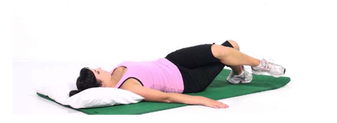 Stretching, particularly when done for rehabilitation or healing (as opposed to mere flexibility for e.g. dancing or martial arts), should always be in pain-free range of movement. Please note that discomfort is unavoidable, especially after injury, it is pain we want to avoid. Go in the direction of the intended stretch, and when you feel the area you are trying to target start to engage, stop. You do not need to go as far as you can, or put on a brave face and ignore too much discomfort. Pain is a warning signal, and while the body gets a bit over-zealous in its protectiveness at times, it is always worth listening to your pain (don’t ignore it or completely give in to it). Current thinking about stretching seems to indicate that gains in flexibility are not due to increasing the length of the muscles (referred to as plastic deformation), but rather due to an alteration in sensation (i.e. the nervous system’s feedback and control systems)[i]. So if we try to take a stretch too far, we are not gaining anything, because it’s pretty much impossible to overrule your spinal cord (imagine trying to not jerk your hand away when you are burned unexpectedly!). If you have ever tried to stretch a muscle out, and get that sort of ‘quivering’ feeling in it; that’s the stretch reflex. In response to ‘stretch’ signals from the tissues involved, your central nervous system (i.e. brain and spinal cord) are sending back instructions to ‘hold on and protect’; so no matter how long you hold that stretch, you are not going to get any relaxation in the muscles. So stretch within your limits. Another question I get asked all the time is how to hold stretches for. Again, this is more about you than it is about me! What is the aim of the exercise? If it is to relax the tissues off, then you want to achieve that goal, right? So if you have been stretching for fifteen seconds, and haven’t felt any release, then continue…! One caveat: if you get to about a minute, and haven’t felt any ease, you may be overstretching the area, even without the telltale ‘quivering’ of the stretch reflex. If that is the case, come off the stretch, get a bit of movement through the area, and either go back in again but more gently this time; or use a more dynamic technique (taking the joint and muscles through their range of movement repeatedly, also known as mobilisation), which is another fantastic way of improving function and decreasing pain (and the topic of yet-another future blog!). If you want a slightly more in-depth look at the science of all of this, I strongly recommend The Science and Practice of Manual Therapy by Eyal Lederman, a British osteopath. It’s a bit dense for the layperson, but riddled with references and research that you can follow up if you like. Depending on the intent/way you go about these, many of these exercises can be performed as a sustained stretch or a dynamic mobilisation. Both of these, but particularly the latter, are also good for improving your proprioception (your sense of where you are in space), which is crucial for neuromuscular control, that is, coordination. So on with the exercises…! 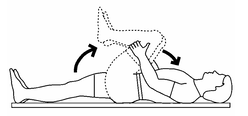 1. Knee hugs / Double knee to chest Lie on your back. Bring both knees up towards your chest. Perform both as a gentle ‘pump’ (30+ times, as a dynamic mobilisation), then as a gentle stretch (hold for 10-30s). 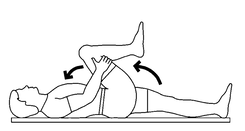 2. Single knee to chest This stretch targets the back of the upper thigh, and gluteal region, rather than the low back itself. Gently draw one leg up to your chest while leaving the other flat on the floor. If necessary, place a small pillow under the extended leg for comfort. You should feel the stretch in the thigh and buttock region. Try moving the leg from side-to-side slightly – this will target different muscles in the hamstring group. Again, you can perform this as a sustained stretch, or as a more dynamic movement. 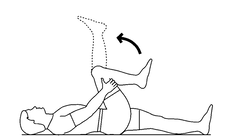 2a. Single knee to chest - variation If bringing the leg up with a bent knee targets the upper fibres of the hamstrings, and using a straight leg targets the lower (and back of the knee, and top of the calf), then it stands to reason that bringing the leg up partway, and then straightening the knee, can target somewhere in between. As before, try drawing the leg up further out to the same side as the leg (to target the inner muscles) or across your body slightly (to target the outer muscles).  3. Gluteal (buttock) stretch This is a particularly relevant area to much low back pain. Even more so than with the hamstrings, there are a heap of muscles in the buttock area. This means that varying the angle at which you take your knee will have even more of an impact on where you feel the stretch. Try to find the tightest/sorest bit, this is likely where needs it most! A good way of doing this is to take the knee around in a gentle arc, and feel for the bits that feel most restricted and/or uncomfortable. As before, do not overstretch, just take the leg over until you start feeling the tissues engage in the affected area(s). 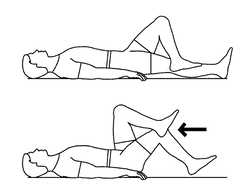 4. Piriformis (hip rotator) stretch Cross one ankle over the other knee. Gently bring that knee towards you until you feel a stretch deep in the buttock region. If you have extremely limited hip and/or knee range of motion you may find this difficult, so may choose to have the other leg flat on the table/bed (as in the top picture in diagram to the [right]. Otherwise, you may start from the lower of the pictures on the [right], or even seated (as below). Try to avoid bending your whole body towards your knees, remember, this is a stretch targeted towards the hip rotators, not your mid/upper back! Also remember to repeat on both sides. 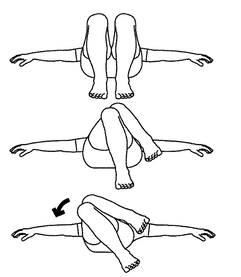 5. ITB (side of thigh and gluteal region) stretch Lying on your back, cross one (in the diagram, the left) leg over the other, and use it to draw the right thigh and leg across the midline of the body (to the left, in this instance). Try and ‘hook’ the calf over the outside of the thigh, this will engage the thick fibrous band that runs between the hip bone and knee and make the stretch more focused. Again, try to think about where you are targeting – in this instance, the very side of the gluteal/hip/thigh region. Once your back starts to twist round and leave the floor/bed, you are no longer stretching the intended area any more, you are now stretching the lower back. This is not necessarily a bad thing, but try to stay focused. If you want to stretch the low back into rotation, there are more effective (and specific!) ways of doing this. 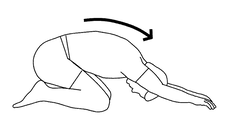 6. Kneel to prayer You obviously need to have a certain range of motion in your shoulders, knees and ankles, as well as hips and low back, for this stretch to be feasible. Do not do any stretch or movement you are unhappy with. From a kneeling position, sink your weight back onto your heels, while stretching your hands as far forward as possible. This rounds (or flexes) the low back (lumbar spine) while straightening (or extending the upper-mid back (thoracic spine). 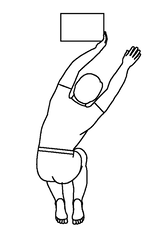 From here, a nice variation is to ‘wiggle’ your shoulders up and down, to introduce some rotation and sidebending into the spine. 6a. Kneel to prayer (variant) Another variant that can be very useful when one side of the back is tighter/sorer than the other is to grasp on object on the opposite side. This will make the stretch much stronger where needed. 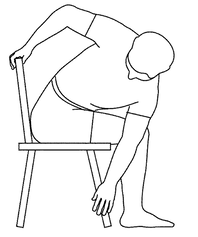 7. Seated combination stretch A nice general stretch that can be played around with to target pretty much any part of the mid or low back. Essentially, imagine you are trying to reach down and touch the floor on the outside of your knee and leg. Changing the amounts of rotation, sidebending and flexion (forwards bending) will change exactly where in the back you will feel the stretch. As long you are gentle and do not push anything too far, you are extremely unlikely to injure yourself, so feel free to play around with the components a bit. 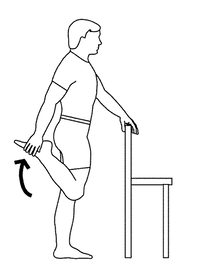 8. Quad and hip flexor stretch Like the muscles on the back of the thigh (the hamstrings), the quadriceps(or ‘four-headed muscle’) on the front of the thigh also can play a big role in maintaining lower back dysfunction. Unfortunately, due to the anatomy of the area, it is difficult to target the whole muscle group. Most stretches will be felt predominantly in the central, superficial muscle (rectus femoris, or ‘straight muscle of the thigh’, if you are interested!). This muscle attaches to the front of the pelvis, so if you stretch it, it will try to tilt the pelvis forward, increasing the arch of the lower back. To prevent this, make sure you ‘tuck your tailbone in’, or slightly tighten your abdominal muscles to help keep the low back nice and neutral. References
[i] Weppler CH, Magnusson SP. Increasing muscle extensibility: a matter of increasing length or modifying sensation? Phys Ther. 2010 Mar;90(3):438–49. All images of exercises in this post are from BioEx Systems' ExercisePro 5 3/11/2018 05:55:35 am
Osteopathic is done to bring the body back to the good condition. When medicines are not suitable this is the right choice. One Path Osteopathy provides Osteopathy in Hornsby to all the patients.
Reply
Leave a Reply. |
AuthorsDrs. Edmund Bruce-Gardner and Soraya Burrows are osteopaths Categories
All
|
|
Osteopathy at Moreland Road Clinic
High quality & personalised service from experienced professionals. A safe, effective & collaborative approach to patient care. All osteopaths undertake a 4-5 year university degree and are licensed and registered healthcare pracitioners. |
Find Us
Moreland Road Clinic 85 Moreland Road Coburg VIC 3058 P (03) 9384 0812 F (03) 9086 4194 osteopathy@morelandroadclinic.com.au |
Popular Blog Posts
|
|
|
Osteopathy at Moreland Road Clinic is on Moreland Road, near the corner of Nicholson Street/Holmes Street, on the border of Coburg, Brunswick & Thornbury.
This makes Osteopathy at Moreland Road Clinic the ideal location for people in the inner north and outer northern suburbs of Melbourne, including: Coburg, Coburg North, Coburg East, Brunswick, Brunswick East, Brunswick West, Fawkner, Oak Park, Glenroy, Preston, Pascoe Vale, Pascoe Vale South, Gowanbrae, Hadfield, Essendon, Moonee Ponds, Thornbury and Reservoir. |
22/10/2018
1 Comment